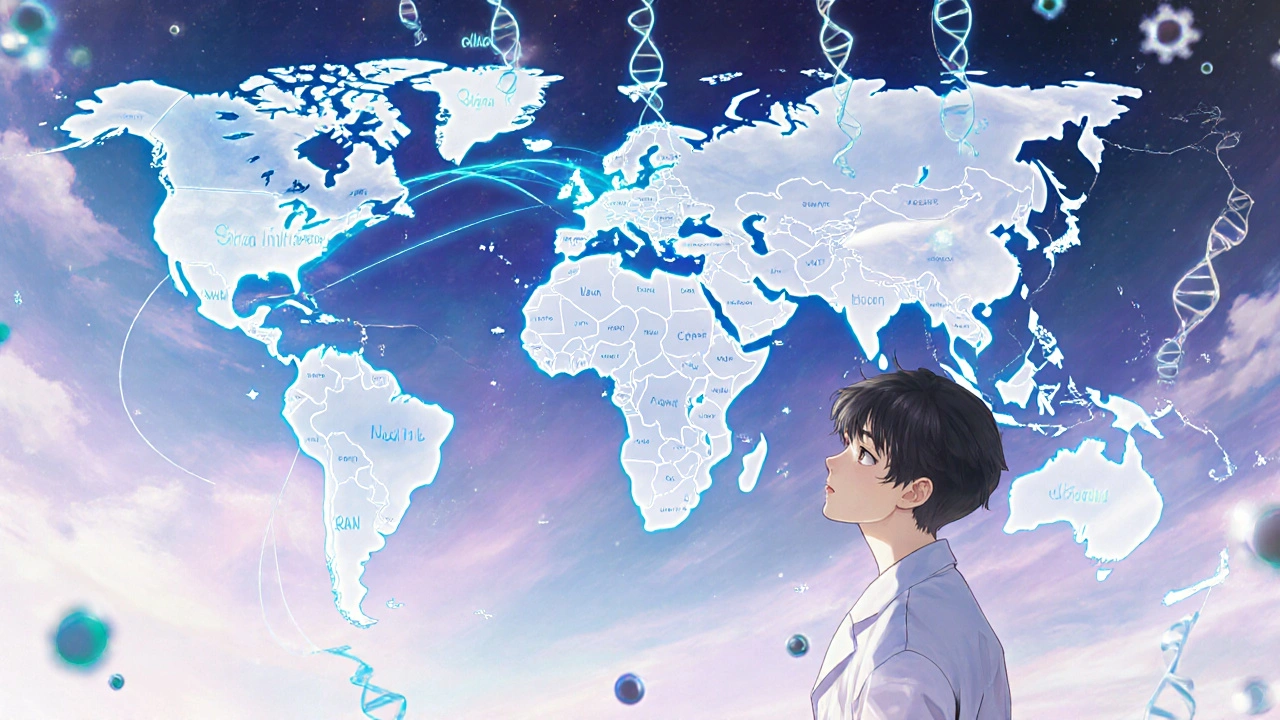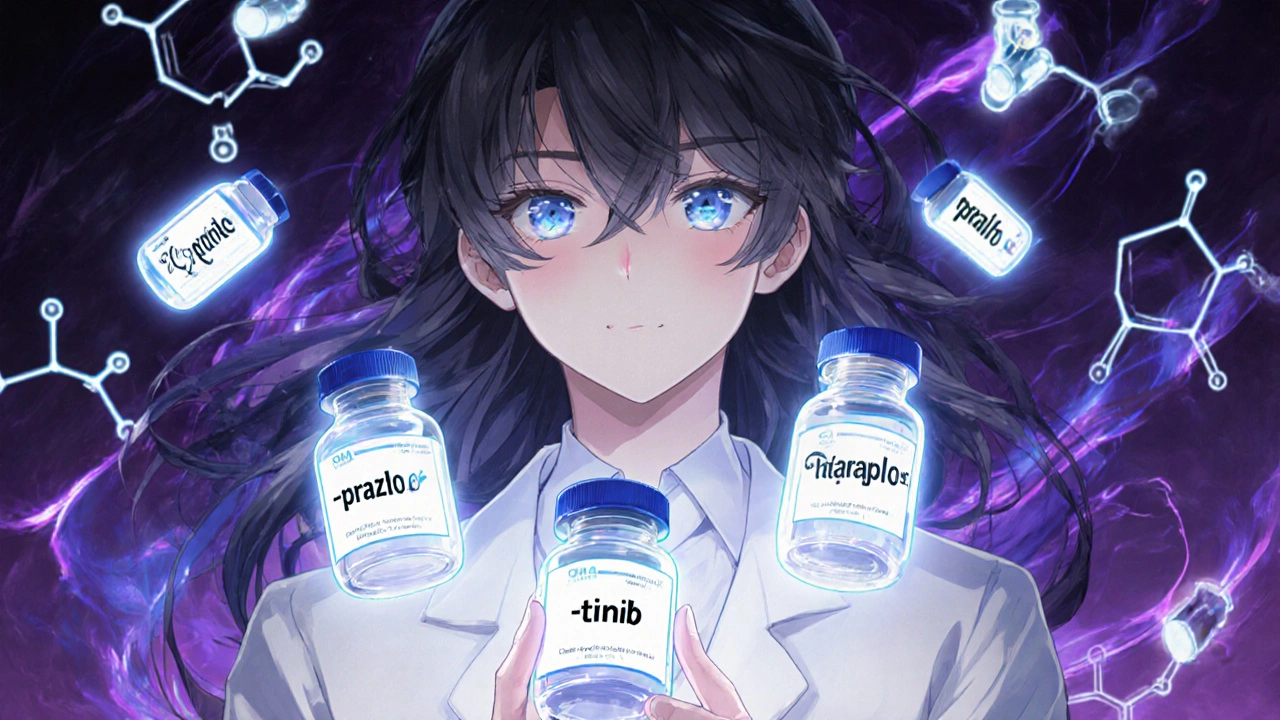Ever picked up a prescription and wondered why the pill has three different names? You might see propranolol on the label, but your doctor called it Inderal, and the pharmacist mentioned something about a chemical name that sounded like a phone number. This isn’t confusion-it’s a carefully designed system. Drug nomenclature exists to keep you safe. Without it, mistakes in prescribing or dispensing could cost lives.
Why Drug Names Matter More Than You Think
Every year in the U.S. alone, over 1.5 million people suffer preventable injuries from medication errors. Many of these happen because names look or sound too similar. Imagine mixing up Hydralazine and Hydroxyzine. One treats high blood pressure. The other treats allergies. Take the wrong one, and you could end up in the ER.
The solution? A global system that gives every drug three clear, distinct names. Each one serves a different purpose. The chemical name tells scientists exactly what the molecule is. The generic name tells doctors and pharmacists what the drug does. And the brand name tells the market who made it.
The Chemical Name: A Molecular Blueprint
The chemical name is the most precise. It’s built using rules from the International Union of Pure and Applied Chemistry (IUPAC). It’s like a DNA sequence for molecules. For example, the chemical name for propranolol is 1-(isopropylamino)-3-(1-naphthyloxy)propan-2-ol. That’s 50 characters long. No one says that in a clinic.
Why do we even have it? Because when a new compound is discovered in a lab, scientists need to know its exact structure. Is it a beta-blocker? An antifungal? A kinase inhibitor? The chemical name leaves no room for guesswork. It’s used in research papers, patent filings, and regulatory dossiers. But outside the lab? It’s useless for daily use.
The Generic Name: The Safety Net
This is where things get smart. Generic names-also called nonproprietary names-are designed to be both simple and informative. They follow a pattern. The ending, called a stem, tells you the drug’s class. The beginning, the prefix, makes it unique.
Take proton pump inhibitors. All end in -prazole: omeprazole, lansoprazole, pantoprazole. You know instantly they work the same way-blocking stomach acid. Tyrosine kinase inhibitors end in -tinib: imatinib, sunitinib, dasatinib. Janus kinase inhibitors? -citinib: tofacitinib, upadacitinib.
This system isn’t random. It’s enforced by two major bodies: the World Health Organization’s INN Programme and the U.S. Adopted Names (USAN) Council. Together, they assign over 200 new generic names every year. And they reject about 30% of proposed names-not because they’re ugly, but because they might be confused with existing ones.
Why the strict rules? A 2020 study found that properly structured generic names reduce medication errors by 27%. That’s not a small number. It’s lives saved. The USAN Council even uses AI now to scan 15,000 existing drug names in milliseconds, checking for sounds, spellings, or visual similarities that could trip up a tired pharmacist at 2 a.m.

The Brand Name: Marketing Meets Regulation
Here’s where pharmaceutical companies come in. They spend millions developing brand names. They want something catchy, memorable, and easy to say. But they can’t just pick anything.
The FDA’s Division of Medication Errors and Technical Support reviews every proposed brand name. They reject about one in three submissions. Why? Because a name like Glucovance could be mistaken for Glucophage. Or Clonazepam might look too much like Clonidine. Even capitalization matters. A lowercase ‘l’ could be confused with a ‘1’.
Brand names also can’t make claims. No QuickCure or HeartStrong. No implying the drug cures, prevents, or is better than others. The FDA requires the generic name to appear just as prominently in all ads and packaging. That’s to remind everyone: this is the same medicine, no matter what logo’s on the bottle.
Companies often start with internal codes during development. Pfizer uses PF followed by numbers-like PF-04965842-01 for abrocitinib. The first eight digits identify the compound. The last two? The salt form. Once it’s approved, they drop the code and give it a brand name: Atopica for cyclosporine, Trintellix for vortioxetine.
Generic vs. Brand: Same Drug, Different Look
Here’s a myth that needs busting: generic drugs are not weaker. They’re not cheaper because they’re inferior. The 1984 Hatch-Waxman Act made it clear-generic drugs must have the same active ingredient, strength, dosage form, and route of administration as the brand. They’re bioequivalent. They work the same.
So why do they look different? Because trademark law says they can’t look identical. A generic version of a blue oval pill can’t be a blue oval pill. It has to be a white circle, or a green rectangle. That’s why patients sometimes think they got the wrong medicine. It’s not the drug. It’s the packaging.
In 2022, the Institute for Safe Medication Practices reported 347 medication errors linked to this exact issue. Someone saw a different-colored pill and stopped taking it-or gave it to the wrong person.

What’s Changing in Drug Naming Today
Drug development is getting more complex. We’re no longer just making small molecules. We’ve got biologics, RNA therapies, peptide-drug conjugates. These need new naming rules.
In 2023, the WHO introduced new stems: -siran for RNA-based therapies, -dutide for peptide-drug conjugates. And for targeted protein degraders-new drugs that break down harmful proteins-the stem will be -tecan. These aren’t guesses. They’re the result of years of global collaboration.
Companies are already using these. For example, a new RNA therapy for high cholesterol might be called lumasiran. The -siran tells you it’s an RNAi drug. The luma- makes it unique. No confusion with givosiran or vutrisiran.
Even the process is changing. AI now helps screen names faster. The USAN Council’s system checks phonetic similarity, syllable stress, and even how a name sounds in Spanish, Mandarin, or Arabic. Global safety means global thinking.
Why You Should Know the Difference
Most patients don’t know the difference between generic and brand names. A 2022 FDA survey found that 68% of patients felt confused by generic names-especially long ones like adefovir dipivoxil or tenofovir alafenamide. But pharmacists? 83% say standardized naming makes their job safer.
Here’s what you can do: When you get a prescription, ask for the generic name. Write it down. Look it up. You’ll find out what class of drug it is. You’ll know if your new pill is in the same family as your old one. You’ll avoid dangerous mix-ups.
And if you’re switching from brand to generic? Don’t panic because the pill looks different. The active ingredient hasn’t changed. The name on the label? That’s your safety net.
How the System Keeps Evolving
The drug naming system isn’t perfect. But it’s the best we’ve got. And it’s getting better. New drug types mean new stems. New technologies mean better screening tools. And more countries are joining the WHO’s INN Programme-now 50 strong.
Every new name is a step toward fewer mistakes. Every stem is a clue. Every prefix is a shield. This isn’t just science. It’s public health infrastructure.
Next time you see a drug name, don’t just read it. Decode it. The ending tells you what it does. The prefix tells you which one it is. And the brand name? That’s just the company’s label. The real power is in the generic name.
What’s the difference between a generic name and a brand name?
The generic name is the official nonproprietary name assigned by health authorities like the WHO or USAN Council. It identifies the active ingredient and its drug class. The brand name is chosen by the pharmaceutical company for marketing. Both refer to the same medicine, but only the generic name is standardized globally. Brand names are trademarked and can vary by country, while generic names stay the same.
Why do generic drugs have such long, complicated names?
They’re not long by accident. Generic names are built with stems that indicate the drug’s class and mechanism. For example, drugs ending in -prazole all inhibit stomach acid production. The prefix makes each drug unique. This system helps doctors and pharmacists quickly identify what a drug does, reducing errors. Even if the name sounds hard to say, it’s designed for safety, not convenience.
Are generic drugs as effective as brand-name drugs?
Yes. By law, generic drugs must contain the same active ingredient, strength, dosage form, and route of administration as the brand-name version. They must also meet the same quality and bioequivalence standards. The only differences are in inactive ingredients like fillers, dyes, or flavorings-which don’t affect how the drug works. Generic drugs save billions in healthcare costs without sacrificing safety or effectiveness.
How are new drug names approved?
The process starts during clinical trials. The drug developer proposes a generic name to the WHO’s INN Programme or the USAN Council. The name is checked for similarity to existing drugs, pronunciation, spelling, and potential confusion in different languages. Around 30% of proposed generic names are rejected. Brand names go through even stricter FDA review, with about one-third rejected due to safety risks. AI tools now help screen thousands of existing names in seconds to prevent errors.
Why do some drugs have different generic names in different countries?
They shouldn’t. The WHO’s International Nonproprietary Names (INN) Programme was created to standardize names globally. Most countries follow INN guidelines. The U.S. uses USAN names, which are usually identical or very close to INNs. Rare differences happen when a country has a longstanding local name, but global harmonization has reduced this to less than 5% of cases. If you see a different name, it’s likely a brand name, not a different generic.
Can a drug’s name change after it’s approved?
The generic name rarely changes once approved-it’s tied to the drug’s identity in medical records and prescriptions. Brand names can be changed by the company for marketing reasons, but this is uncommon and requires FDA approval. If a name is later found to cause confusion or safety risks, regulators can issue warnings or even require a name change. For example, in 2019, the FDA asked a company to change a brand name after it was too similar to another drug on the market.
